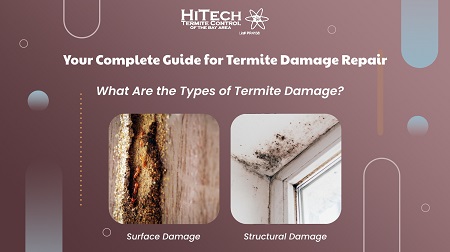Your Complete Guide for Termite Damage Repair
 Termites often work stealthily. Without timely detection and control methods, they can wreak havoc on structures, resulting in house owners spending several hundreds on termite damage repair.
Termites often work stealthily. Without timely detection and control methods, they can wreak havoc on structures, resulting in house owners spending several hundreds on termite damage repair.
If your house has suffered mild or severe termite damage, the first question on your mind will be“How should I fix it?”If you want to understand the intricacies of termite damage and the correct ways to address it, then you are at the right place.
What Are the Types of Termite Damage?
The first step toward repairing termite damage is to identify the type of termite damage. The extent of termite damage will determine what type of repair treatment you should choose.
Here are the two main types of termite damage:
Surface Damage
This is the first type of damage that you will spot in a house with a recent termite infestation. Surface damage refers to the early stage of damage that is present only at the surface level of the structure. This damage, when left untreated, will extend to the structural elements of the building.
Signs of surface termite damage include:
- Minute holes on wooden furniture or other wood in the house
- Cracks and holes in the wallpaper or drywall
- Bubbling of the paint and floor
Also Read: How to Kill Termites the Natural Way?
Structural Damage
Structural damage is severe damage that indicates that the termites have been eating away at the structure for a long time. This type of damage can compromise the safety of the whole structure and it can even make the structure collapse.
Here are some of the signs of structural termite damage that you should look out for:
- Sagging or buckling of the ceiling or floors
- Cracks on the walls or ceiling
- Stuck doors or windows
These are some of the obvious signs of damage to the foundation. If termites get access to your foundation, then you have to take immediate action since any delay will be dangerous for the structure.
The professionals from termite control companies are trained to identify and repair termite damage. Hence, make sure that you find the best termite control company and get their help with termite damage.
How to Fix Termite Damage?
Once termite damage is identified, the person from the termite control service will elaborate on the course of action. Getting the advice of a professional can help you repair the damage and also prevent future infestations.
Repairing Surface Damage
Surface damage might seem harmless especially when compared to structural damage but you should keep in mind that the minute holes and cracks might serve as entryways for future termite infestations.
To maintain the aesthetic appeal of your house and also to prevent further weakening of the structure, address the surface damage thoroughly.
- Using Wood Hardeners
For places with minimal damage, you could slightly sand or chisel the spot and then fill the gap with wood hardeners. After the hardener dries, sand it so that it is smooth. You could even paint the place with the hardener in the same color as the other surfaces.
- Using Epoxy Resin
Epoxy resin is also similar to wood hardeners. This strong adhesive will fill in the gaps resulting from termite damage. You should use the resin in the same way that you use the wood hardeners.
Often, with surface-level damage, people choose DIY methods but they are spot remedies. In most cases, the termite damage reoccurs. Professional termite control experts are trained to find the root of the termite problem and thus can provide a more effective, long-term solution.
Also Read: How Do You Know if You Have a Termite Infestation?
Repairing Structural Damage
Foundation damage means that the structure is unsafe to live in. Hence, it is important for you to immediately address the problem of structural damage.
- Replace Damaged Wood
This is a common method for treating structural damage. You should cut out the damaged wood and then replace it with new wood. You can use wood that has been treated for termites beforehand.
It is better done by a professional since it involves cutting out crucial parts of the structure and replacing them with new wood. This is a long process but it is the best way of treating extensive termite damage.
- Providing Additional Support
If the termite damage is severe but the structure can hold with extra support, then you could provide it with joists.
For that, you just have to attach new joists to the damaged ones so that they give extra strength to the structure.
HiTechTermite Control
Regular termite inspections can help you save a lot of money since professionals can identify a termite infestation before it gets out of hand. To schedule a termite inspection with HiTechTermite Control and to check out the termite damage repair services we offer, visit our website here.
- Dec 20, 2023
